
The Private Hire RFs, 1RF1/2
RF 1 - RF 25, Total 25
This page created 12th December 1997, updated 17th January 2022.

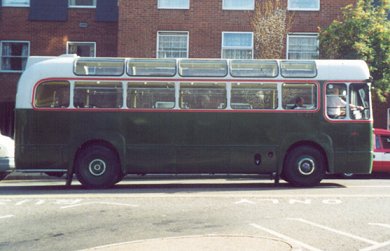 The Private Hire RFs, besides being the first, were very distinctive.
They were only 27ft 6in long, instead of the 30 ft of all the others,
and they had glazed cant panels in the sides of the roof.
The Private Hire RFs, besides being the first, were very distinctive.
They were only 27ft 6in long, instead of the 30 ft of all the others,
and they had glazed cant panels in the sides of the roof.
The length was the original planned length for the class,
being the maximum allowed.
Once the news arrived that 30 ft was to be allowed the plans were re-drawn.
Each operating department would have a say whether they wanted shorter or longer models,
or a mix to cover various duties. There could have been a multiplicity of types.
In the end all the RFs except this first batch were to the longer length,
with duties requiring shorter buses in the Country Area being continued by
C,
CR
and T
class buses until the GS came along.
Preserved RF4 at Hertford Running Day, September 2000
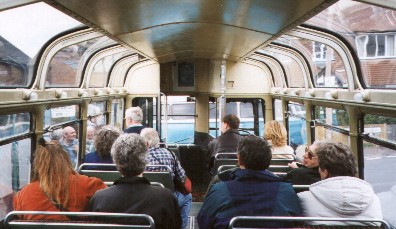
The Private Hire RFs could not wait for the new regulations:
they were needed urgently for the Festival of Britain private hire business starting in May 1951.
Some made it in time for the first day, and all 25 had been delivered by 1st June.
They worked alongside the remaining Private Hire TF
(TF9) and the 24 Private Hire Renowns (LTC 1-24),
which they would displace once the season was over,
and the equally new RFWs.
Inside RF4 at the East Grinstead Running Day, 1998.
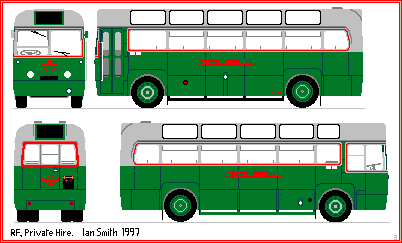 The new buses certainly looked distinctive, in a livery of Lincoln green below the waist,
and flake grey (almost white) above. The curving window surrounds were in flake grey,
lined with two thin stripes of red. The London Transport fleetname and the bullseye
motifs on the radiator filler flap and rear door were also in red.
Inside, the decor was intended to be light: green up to waist level,
pale green up to just above the windows, and a cream ceiling.
The cant panels could be shaded by blinds hidden in the ceiling.
The new buses certainly looked distinctive, in a livery of Lincoln green below the waist,
and flake grey (almost white) above. The curving window surrounds were in flake grey,
lined with two thin stripes of red. The London Transport fleetname and the bullseye
motifs on the radiator filler flap and rear door were also in red.
Inside, the decor was intended to be light: green up to waist level,
pale green up to just above the windows, and a cream ceiling.
The cant panels could be shaded by blinds hidden in the ceiling.
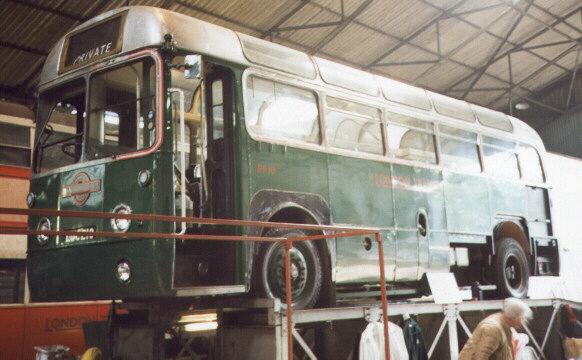 The 25 coaches were all allocated to Central Area garages. Initial allocations:
The 25 coaches were all allocated to Central Area garages. Initial allocations:
Camberwell (Q): RF 2, 7, 8, 12
Holloway (J): RF 9, 21, 23
Merton (AL): RF 5, 14, 15, 25
Middle Row (X): RF 11, 19, 20
Riverside (R): RF 1, 6, 10, 16
Streatham (AK): RF 4, 13, 18
Upton Park (U): RF 3, 17, 22, 24.
(Left) RF 10 receives attention at Cobham, showing how the detachable skirt panels assist maintenance.
The buses settled down to work, including operation of the London River Tour
which involved a crossing of the Woolwich Free Ferry.
Tours such as this and the West End Seeing London Tour made good use of the
glazed rof panels, but the market for London Sightseeing was not as great in
the 1950s as it became in the 70's.
London Transport was prohibited by law from using them for excursions beyond the London Area:
Windsor, Ascot and Epping Forest were about as far out as they got!
The Private Hire RFs were soon to be found on a staple diet of contract work
for which they were not best suited.
(It was mooted that some TDs should be modified to release them from contract work,
but the idea never reached fruition). The rest were laid up during each winter,
returning to hire duties during the summer months.
So when there was a shortage of Green Line RFs in the mid fifties,
ten of the Private Hire RFs were transferred to the Country department for operating Green Line services.

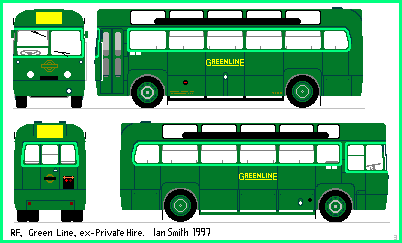
The short Green-Lines:
RF 16-25, 1/1RF1/3
The transferred buses were repainted into standard Green Line livery,
and as convenient had lightweight luggage racks fitted inside,
of a new design that would not cut out the light from the glazed panels.
They were also fitted with clips for the Green Line's distinctive coach boards.
They went to various garages around the Country Area, but also featured as the
emergency vehicles kept in Central London to take over services for ailing or seriously delayed coaches
(eg RF 22 was kept at Victoria garage (GM), and RF 24 at Riverside (R)).
Even with these coaches officially transferred, there were also many occasions
when the remaining Private Hire coaches were called into Green Line service too.
These coaches were sold in 1963 (along with the other Private Hire coaches),
when the advent of the double-deck
Green Line Routemasters created a surplus of Greenline RFs.
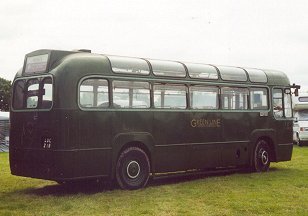
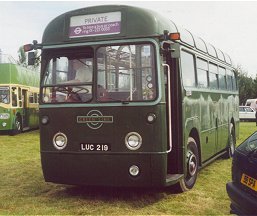
RF19 has been restored to GreenLine livery by Colin Curtis. They are seen here at Lingfield Show, August 2000.

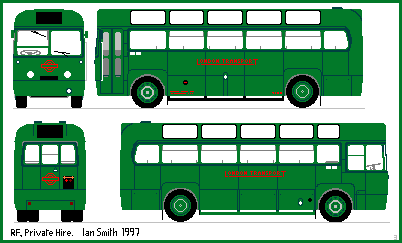 The continuing Private Hire RFs presently came to overhaul
- and emerged as swans converted to ugly ducklings!
The elegant off-white with red lining had vanished in favour of overall Lincoln Green,
with no lining of any kind. The fleet name stayed in red, giving an overall very drab effect.
Somebody did NOT like the private hire sector!
The continuing Private Hire RFs presently came to overhaul
- and emerged as swans converted to ugly ducklings!
The elegant off-white with red lining had vanished in favour of overall Lincoln Green,
with no lining of any kind. The fleet name stayed in red, giving an overall very drab effect.
Somebody did NOT like the private hire sector!
In 1963, when LT was having terrible trouble finding staff,
so that overtime was being required to run the stage services,
it was decided to abandon the private hire sector in the Central Area
(or rather to hire in from private operators as required).
So the Private Hire RFs were put up for sale (there was an RF surplus by this time)
and they were all withdrawn between August and October 1963.
They were snapped up like hot cakes by independent operators,
such as Premier Travel of Cambridge,
Osborne's of Tollesbury, Super Coaches of Upminster, and Hampsons of Oswestry.
Others went to other operators throughout the UK and Ireland.

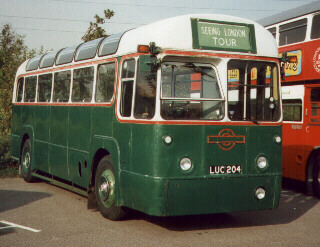
Preserved 1RF1s
RF 4 LUC 204 Bob Duker
RF10 LUC 210 London Bus Museum
RF12 LUC 212 Bob Duker
RF13 LUC 213 Quantock Heritage
RF16 LUC 216 Bob Duker
RF19 LUC 219 London Bus Museum
RF20 LUC 220 Peter Penfold ?
RF4 at Stoke d'Abernon, October 1997, on the RF Running Day.

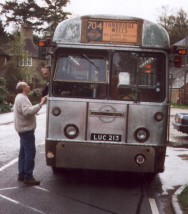
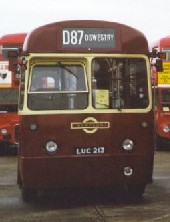
(left)Mike Dawes tells Ray how to get to the Running Day in East Grinstead, April 98.
RF13 had been stripped to bare metal before a repaint into Hampson's livery, seen partly completed at Showbus 98 (right).
Photos by Ian Smith. Click for larger ones

 coach histories coach histories
 photographic references photographic references

 Ian's Bus Stop Ian's Bus Stop
 RF Contents RF Contents
 Private Hire RFs Private Hire RFs
 RFWs RFWs
|



 The new buses certainly looked distinctive, in a livery of Lincoln green below the waist,
and flake grey (almost white) above. The curving window surrounds were in flake grey,
lined with two thin stripes of red. The London Transport fleetname and the bullseye
motifs on the radiator filler flap and rear door were also in red.
Inside, the decor was intended to be light: green up to waist level,
pale green up to just above the windows, and a cream ceiling.
The cant panels could be shaded by blinds hidden in the ceiling.
The new buses certainly looked distinctive, in a livery of Lincoln green below the waist,
and flake grey (almost white) above. The curving window surrounds were in flake grey,
lined with two thin stripes of red. The London Transport fleetname and the bullseye
motifs on the radiator filler flap and rear door were also in red.
Inside, the decor was intended to be light: green up to waist level,
pale green up to just above the windows, and a cream ceiling.
The cant panels could be shaded by blinds hidden in the ceiling.




 The continuing Private Hire RFs presently came to overhaul
- and emerged as swans converted to ugly ducklings!
The elegant off-white with red lining had vanished in favour of overall Lincoln Green,
with no lining of any kind. The fleet name stayed in red, giving an overall very drab effect.
Somebody did NOT like the private hire sector!
The continuing Private Hire RFs presently came to overhaul
- and emerged as swans converted to ugly ducklings!
The elegant off-white with red lining had vanished in favour of overall Lincoln Green,
with no lining of any kind. The fleet name stayed in red, giving an overall very drab effect.
Somebody did NOT like the private hire sector!


 coach histories
coach histories Ian's Bus Stop
Ian's Bus Stop RF Contents
RF Contents Private Hire RFs
Private Hire RFs